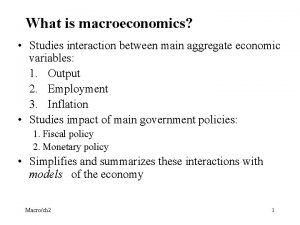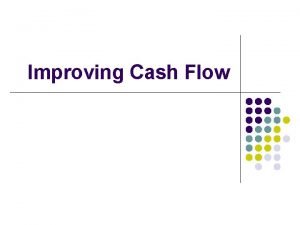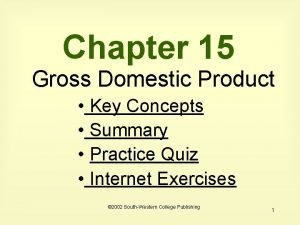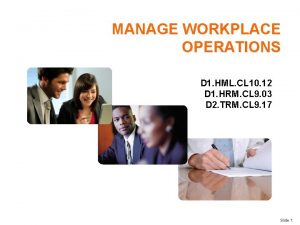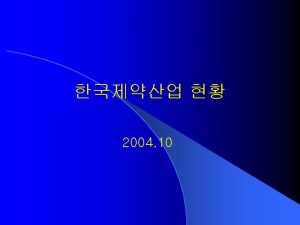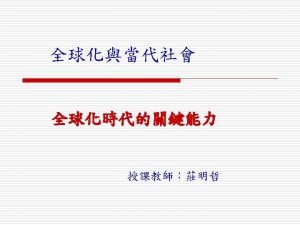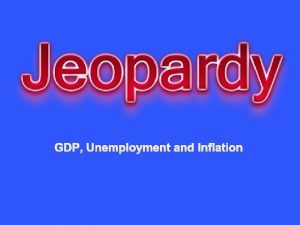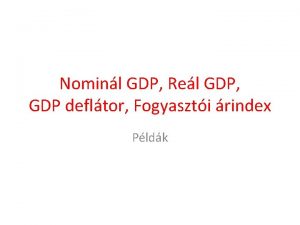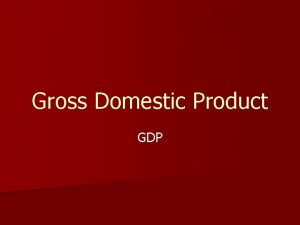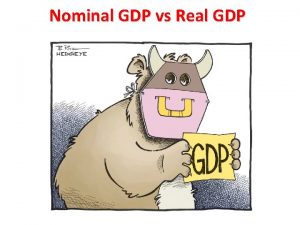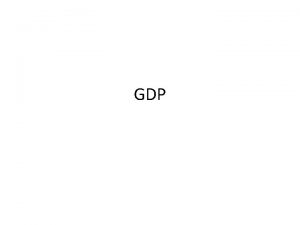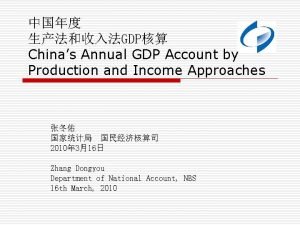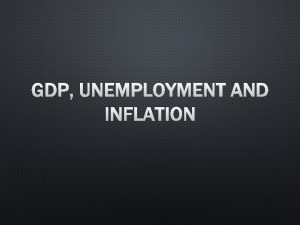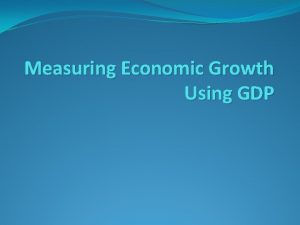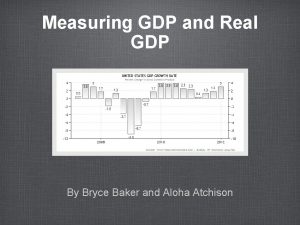How does GDP improve lives Literacy and Education


















- Slides: 18

How does GDP improve lives • Literacy and Education • Studies show that countries with a high per capita GDP have high levels of education. These countries also tend to have literacy rates at or near 100 percent.

How does GDP improve lives • Health and life expectancy: • People live longer in countries with high per capita GDP than in countries with low per capita GDP. • Infant mortality rates are also lower in countries with high per capita GDPs.

How does GDP improve lives • Standard of living: • People in countries with high per capita GDP tend to be more prosperous than people in low per capita GDP countries. • They have more access to services and higher amounts of food and clothing.

Inflation and Economic Health • Inflation is an increase in the overall price level of goods and services produced in an economy. • The inflation rate is the percentage increase in the average price level of goods and services from one month to the next.

Inflation • The Consumer Price Index (CPI) is a price index for a “market basket” of consumer goods and services. • Changes in the average prices of these items approximates the change in overall cost of living for the average American. • Because of this, the CPI is sometimes called the costof-living index. • It serves as the primary measure of inflation in the United States. (Bureau of Labor Statistics)

Inflation • CPI is tied to the COLA (Cost of Living Adjustment). Social Security is tied into the CPI, and is adjusted accordingly each year based on the inflation rate. • The COLA is added in to each Social Security Check.

Inflation • • CPI Market Basket: Housing – 42% Transportation – 18% Food/Beverages – 15% Medical Care, Recreation, Education – 6% Apparel – 4% Other goods and services – 3%

Inflation • Core CPI: This refers to the rate of inflation excluding the effects of food and energy prices. • Between 1974 -1980 inflation spiked rapidly, largely due to increases in prices in world food and oil markets. • In order to study long term trends in the market, analysts need the ability to set aside temporary spikes in food and fuel prices. • Thus, we see core CPI

The Economic Costs of Inflation • Loss of purchasing power: the amount of goods and services that can be bought with a given amount of money. • Higher interest rates: The expectation that inflation will erode future purchasing power drives up interest rates. In times of high inflation, lenders pay close attention to the real interest rate on the money they loan. • Loss of economic efficiency: Uncertainty/Bad • Shortages of certain goods: hoarding.

Inflation • Hyperinflation occurs when runaway inflation creates extreme uncertainty in an economy. • Examples: Germany in the 1920’s, Zimbabwe recently.

GDP • Nominal GDP – Currently 14. 5 Trillion Dollars. Measures the output of an economy at current prices. • Real GDP – Measures the output of an economy not in current dollars, but at constant dollars. The value of the constant dollars is fixed at a rate that was current in a specified base year. • Real GDP allows economists to compare the total output of an economy from year to year as if prices had never changed.

Causes of Inflation • The Federal Reserve Bank increasing the amount of money in circulation. The greater the amount of cash in circulation, the higher the prices that businesses will charge for goods and services. • Generally, raising interest rates tends to lead to lower inflation. Banks lend less money. • Generally, lowering interest rates tends to lead to higher inflation. Banks lend more money. • The goal is to find the middle ground, balancing interest rates and inflation. (Investment as well)

Causes of Inflation • Demand-Pull Theory: This states that inflation will occur when demand for goods and services exceeds existing supplies. Examples: Furbies, Pumpkins this year, Tickle Me Elmo.

Causes of Inflation • Cost-push theory: This states that inflation occurs when producers raise prices in order to meet increased costs. • Higher production costs reduce the economy’s ability to supply the same output at the same price level. (Ex: Bakery – Inputs) • The rising cost of land, labor, or capital “pushes” the overall price level higher.

Inflation • The Wage-Price Spiral: Workers demand higher wages in order to keep up with rising inflation. Employers will pay higher wages but also raise prices even higher to cover their increased production costs.

Inflation • Deflation occurs when prices go down over time. • Deflation is good for consumers, lenders, and savers. The value of every dollar they set aside will increase over time as prices fall. • Deflation is bad news for businesses. Prices drop/people put off spending/wait for deals. • What might happen next?

Inflation • Slowed spending= Drop in revenues. Later on lower wages and lay-offs, ultimately bankruptcy.

Inflation • Stagflation: The situation that exists when economic stagnation combines with high inflation. • During a period of stagflation, GDP growth is slow or zero, unemployment is high, and prices are rising.
 What is included in gdp
What is included in gdp What is nominal gdp
What is nominal gdp Purpose people process
Purpose people process Media literacy vs information literacy comparison
Media literacy vs information literacy comparison Venn diagram of media information and technology literacy
Venn diagram of media information and technology literacy Who do you think are people media?
Who do you think are people media? Cyber literacy and digital literacy
Cyber literacy and digital literacy How does debt factoring improve cash flow
How does debt factoring improve cash flow What does the gdp measure
What does the gdp measure What does the gdp measure
What does the gdp measure School education and literacy department
School education and literacy department Als vs formal education
Als vs formal education Financial literacy and education commission
Financial literacy and education commission Education and literacy department govt of sindh
Education and literacy department govt of sindh What role does nature play in our lives?
What role does nature play in our lives? Disciplinary literacy in physical education
Disciplinary literacy in physical education How does literacy rate affect the standard of living
How does literacy rate affect the standard of living Ways to improve urban infrastructure
Ways to improve urban infrastructure How to monitor and improve workplace operations
How to monitor and improve workplace operations

